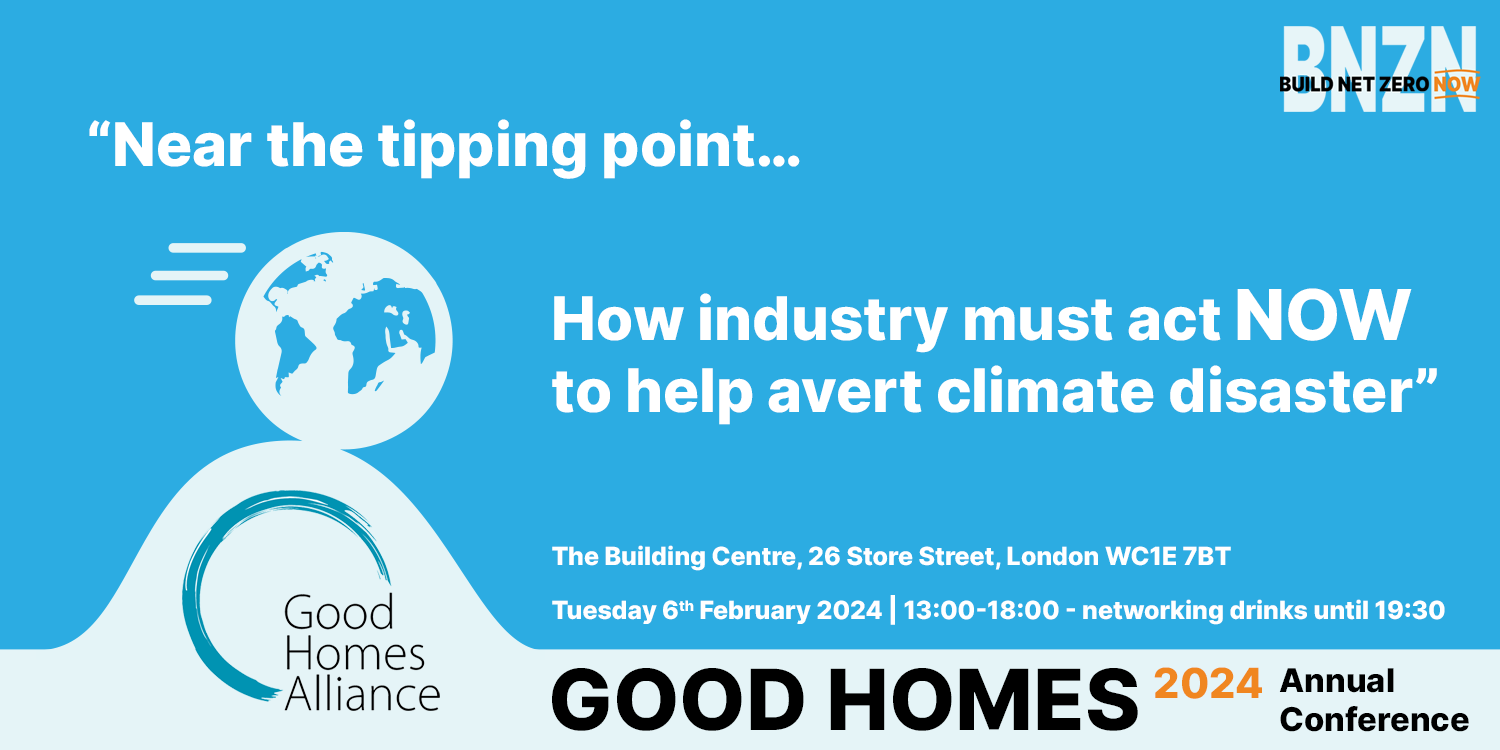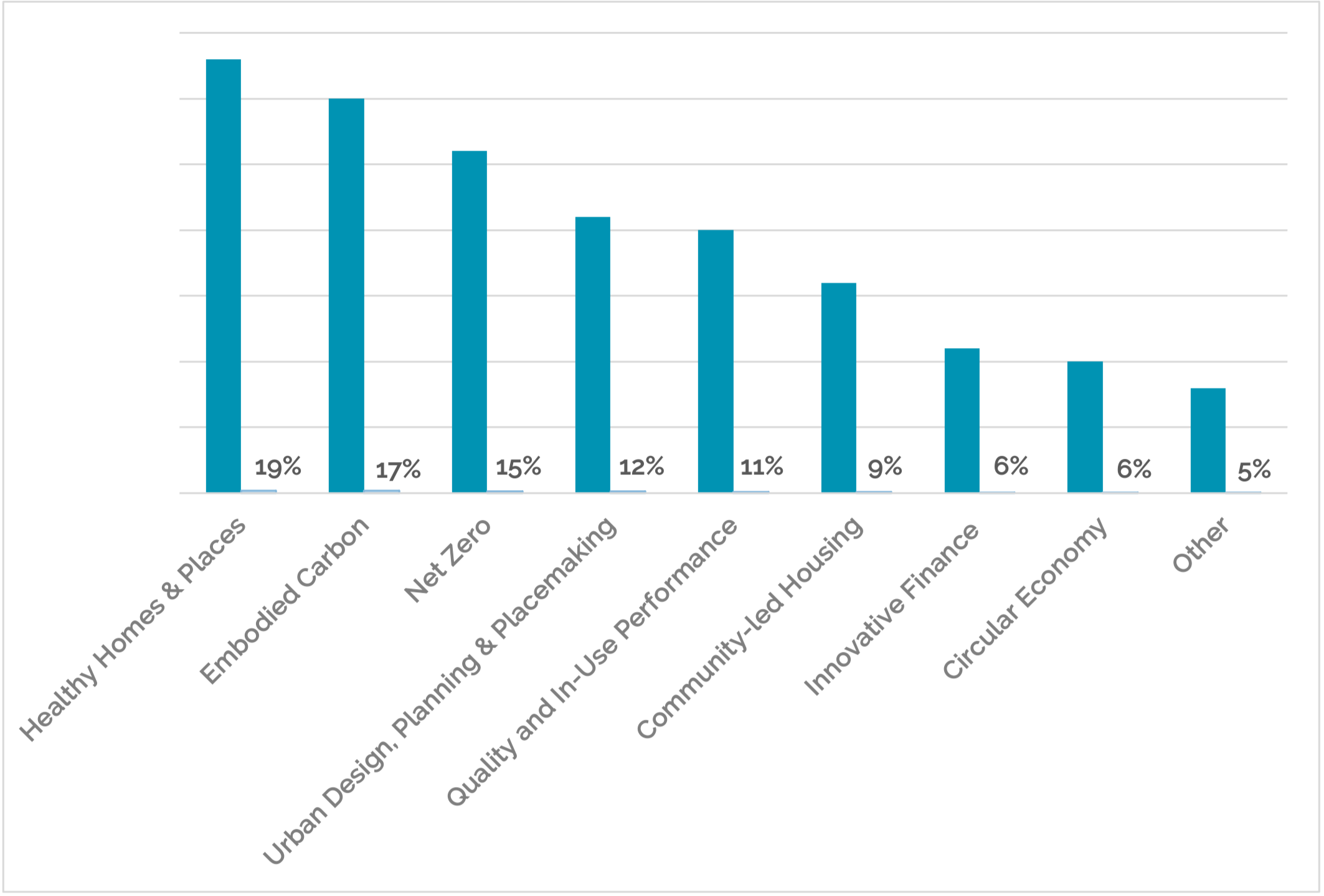
Authored by Sophie Hockley, Good Homes Alliance
“Near the tipping point… How industry must act NOW to help avert climate disaster”
Our annual conference took place on Tuesday 6th February 2024 at the Building Centre in London. We had a full house with nearly 150 delegates in attendance from across the sector, including local authorities, developers, housing associations, architects, consultants and more.

The 2024 conference was again held under the ‘Build Net Zero Now’ banner. As we enter phase 3 of this campaign, we are at a pivotal moment: with both the current government and the Labour Party aiming to deliver 300,000 new homes per year, the quality and performance of those homes is critical if we are to stand any chance of meeting our Net Zero targets and delivering homes ‘fit for the future’.
Chaired by GHA Chair Lynne Sullivan OBE, the format of the conference was a mix of discussion, debates and networking, with sessions featuring experts speaking on some of the key issues relating to the sustainable housing agenda:
Session 1: Build Net Zero Now
Panel discussion – Net zero planning policy and Future Homes Standards

Chaired by Lynne Sullivan, Chair of the Good Homes Alliance, with:
- Hugh Ellis, Director of Policy, Town & Country Planning Association
- Thomas Lefevre, Director, Etude Sustainability
- Marina Goodyear, Senior Technical Consultant, Bioregional
- Emily Rubin, Principal Development Officer, Cornwall Council
- Julie Godefroy, Technical Steering Group member, Net Zero Carbon Buildings Standard
- George Martin, Chair, Building Performance Network
This wide-ranging discussion covered a number of areas, including:
- The need for joined-up infrastructure planning for Net Zero and how a land-use planning framework might identify transport, energy, nature and water needs for future development.
- The influence of carbon accounting at local levels and how this could affect the alignment of building standards for Net Zero.
- The role of Whole Life Carbon assessment when there is no regulated methodology for embodied carbon in the UK.
- Local energy planning for local carbon benefit within the context of global energy markets.
Some points from the discussion:
- All advanced economies need some form of effective planning; without a regional approach you can’t address environmental capacity issues such water management or take a joined-up approach to flooding and coastal erosion.
- In places such as Cornwall, the Climate Emergency Development Plan Document (DPD) is increasingly bringing together every aspect of emissions reductions that can be achieved through planning.
- Carbon accounting for climate change requires the allocation of responsibility at different levels. One challenge with local level reporting is that there is frequently a lack of data to verify reporting.
- There are different views as to when and how to factor in embodied carbon, but there was some agreement among the speakers about the need to address regulated and unregulated energy use first.
- The need for strategic planning is underlined by the fact that planning decisions and carbon emissions often extend beyond the local area (e.g., renewable energy production and transport). These need to inform local decisions such as where – and at what density – to deliver growth.
- The more we understand about embodied carbon, the bigger issue it becomes. As such, the built environment sector has a responsibility to reduce waste, understand what we are using, and balance budgets over time (e.g., how much embodied carbon to use in retrofit etc.).
Once again, much better data is needed, but increasingly authorities will require disclosure, and challenge proposals that make use of excessive amounts of embodied carbon.
Panel discussion – Net Zero Housing and Finance

Chaired by Neil Murphy, Director, TOWN, with:
- Rafe Bertram, Built Environment Sustainability Lead, Enfield Council
- Rachael Hunnisett, Green Mortgage Campaign Lead, Green Finance Institute
- Tom Hill, Director, Impact Management, Savills Earth
- Stephanie Landymore, Sustainability Lead, Ecology Building Society
- Philip Graham, UKRI Design Innovation Scholar at Cambridge University (Homerton College) & architect at Cullinan Studio
This session explored some key trends and developments and, whilst recognising that systemic shifts are needed, there was optimism about:
- The FCA finally consulting on green standards and greenwashing.
- Technological tipping points (e.g. leasing roof space for PV).
- The increasing availability of green mortgages. (Though it was noted that this is still a new market, these are loss-leading products and potential negative impacts on other parts of the housing market need to be avoided. Although only 38% of homes in the UK are mortgaged, this is where transactions are taking place.)
- The positive benefits of impact investment – generating financial returns as well as positive environmental or social impacts – which can change the market, and in turn influence policy. (One examples from Savills is the use of a fund to enable people to move to more secure housing, and linking this to improved educational outcomes.)
- The potential influence of green finance on how homes and towns are designed (e.g., the climate, social, health and welfare benefits of thinking about how space is used).
One point that was raised in the engaging Q&A that followed was the role of consumer demand (a big Victorian house with a log burner and a Range Rover) and behaviour change. All things that could be considered outside of the remit of the finance sector, and yet finance innovation is part of the solution, in addition to government changing incentives and tax policies.
Session 2: Adaptation and regeneration

Shading for housing: Designing for a changing climate
Tom Dollard, Partner – Sustainability and Innovation, Pollard Thomas Edwards
It is estimated that by the middle of the 2030s, 90% of UK housing stock will suffer from overheating. Shading therefore needs to become an integral part of housing design. We used to do shading design really well in this country, but it is something that in an era of cheap energy became superfluous. This guidance for designers and clients combines a focus on good design with supporting technical detail. The 19 product case studies are evaluated using several criteria, which found that external dynamic shading scored best, followed by external fixed shading, with internal shading – the current ‘go-to’ for new builds – coming in last.
There is no free design solution, but this is an issue that needs an ongoing design focus, not just when there is a heatwave. Although fixed options might be preferred by some providers as they are easier to maintain, other shading options were found to have minimal impacts on maintenance regimes. This guidance has been well received, and some local authorities have already written this into their planning requirements. It is also being used by a number of designers and developers.
Enhancing biodiversity in housing developments
Sue Young, Head of Land Use Planning, The Wildlife Trusts
Housebuilders have a key role to play in enhancing biodiversity in new developments. Whilst biodiversity net gain will be mandatory from next week, The Wildlife Trusts is calling for gold standard biodiversity net gain: Nature locks up carbon, but it also releases carbon when damaged. Despite the UK having important habitats – including woodland and peatland – nature is in dramatic decline, with a halving of abundance within Sue’s lifetime. One of the greatest threats to nature is climate change, yet nature is also important for mitigating climate change, from temporary floodwater storage in green space, to reducing the heat island effect and providing shade, cooling and recreational space.
Strategic planning and a land use framework is important, as is the need to provide the right homes in the right places, using nature and people-centred design within environmental limits. Developments can be built in ways that benefit nature, from high standards for NZ, water efficient designs and considered locations (avoiding floodplains and areas that aren’t close to transport links), to the planting of native species in ponds, swales and raingardens as part of effective SuDS, the enhancement of existing features (hedges, ponds, mature trees), and the provision of both homes and wider landscapes for a variety of species. All of which provides win-win solutions for people and places.
Enabling Water Smart Communities
George Warren, Integrated Water Manager, Anglian Water
‘Enabling water smart communities’ is a partnership project to address current and future water and housing challenges. A water smart community will mean different things to different people, but can be defined as ‘a place where water is central to the design, where people embrace the principles of water stewardship and where they are empowered by assets and systems to use water wisely’. The project is bringing together multiple stakeholders to rethink whole life water management. Currently in the discovery phase, a framework has been established to identify and prioritise project activities using three types of leverage points: value, assets and stewardship. This includes rethinking how water could and should be managed, involving community groups and anchor institutions, and ensuring stewardship is in place to enable projects to succeed. One of the initial action projects is community water reuse. The project leads are keen to obtain more data about the financial burden to developers, and to engage with the sector to find out more about real barriers to delivering these solutions. Further details at ewsc.org.uk.
Session 3: Collective action to accelerate change

Chaired by Jon Bootland, Director, Sustainable Development Foundation
Using the GHA manifesto as a starting point. In this anticipated election year, each panel member was asked to make the case for one policy action, and to outline how it would be delivered and what it would achieve:
Net Zero: Julie Godefroy, Head of Net Zero Policy, CIBSE / Technical Steering Group member, UK Net Zero Carbon Buildings Standard (NZCBS)
– Julie made the case for Net Zero policy as a stepping stone towards NZCBS, with regulations as a backstop, not an end goal. This would include whole life carbon, with standards based on outcomes – annual records of actual energy use, a science-based approach to policy, and the ability of local authorities to set related policies.
Healthy Homes: Rosalie Callway, Projects and Policy Manager, TCPA
– Rosalie called for the next government to support the TCPA’s Healthy Homes Bill and to embed these healthy homes principles: 1 in 10 people in the UK live in homes that fail to meet decent homes standards; people living in poor quality housing are twice as likely to have poor health, which costs the NHS in excess of £2billion per year. The current narrative is all about more homes, but we can have healthy homes too.
Community-led Housing: Tom Chance, Chief Executive, Community Land Trust Network
– Tom’s ask was for 5% of the market to be community-led housing. Community agency matters – increasing community stewardship leads to better outcomes, and yet there’s very little consideration of community demand in the current system. Despite this, both the vision and the practical experience already exists. To scale this up, a growth lab (to develop new products and enabling services) and a growth fund (to de-risk and reduce the financial cost) are needed.
Embodied Carbon: Seb Laan Lomas, Associate and Passivhaus Designer, Architype/ Coordinator, Architects Climate Action Network (ACAN)
– Embodied carbon accounts for 11% of global emissions, yet it is completely unregulated in the UK. Seb’s argument was that this needs to change: the CCC has called for this, industry is ready, and a number of proposed policies have been put forward. As a co-benefit, this regulation would support a just transition to a bio-based, circular and retrofit first industry. How to take this forward? Look to the Netherlands, France, Sweden, Denmark, Norway, Finland, the USA and Canada.
Building Performance In-use: George Martin, Chair, Building Performance Network
– George made the case for people to use, and provide feedback on, the BS40101. Very few developers use low carbon or NZ in their advertising materials, and yet this is a strong selling point. The BS40101 could be developed into a more exciting looking document, but this is a triage system that we need to use in England, Wales and Northern Ireland. Scotland, on the other hand, no longer needs this – they’ve decided their building regulations need to meet passive house standards or the equivalent.
Circular Economy: Katherine Adams, Technical Director, The Alliance for Sustainable Building Products (ASBP)
– Katherine called for a move to a circular economy. We used to be very good at this, but just 9% of materials currently go back into circulation. There is a huge amount of waste on building sites, and individual households also have many items that are rarely used, and could be better sourced through a Library of Things. We also need to change how we design, and become more efficient with our use of multifunctional spaces. There are many benefits to moving towards a circular economy, including lower carbon emissions, less water and air pollution, and less land required for the extraction of materials.
Innovative Finance: Rafe Bertram, Built Environment Sustainability Lead, Enfield Council
– The GHA’s 10 step finance manifesto was held up as the starting point for Rafe’s call for a more innovative finance ask, which would include strong and precise ESG criteria (see the GFI’s advice to government); a more serious consideration of public value; the retention of EPCs until something better is in place; and a focus not just on financial, but also on environmental and social growth.
Urban Design, Planning & Placemaking: Lynne Sullivan, Chair of the Good Homes Alliance
– Lynne’s policy ask was for a National planning plan that would match the scope and ambition of the post-war Town and Country Planning Act, and provide the basis on which we can develop new, restore old, and support existing communities. It would include land use, local area energy planning, local resource planning, adaptation strategies and environmental net gain.
We were all invited to vote on our preferred policy ask, and the winner was…

If you have other ideas or suggestions for top priorities, please do get in touch. These will help inform our work in the next phase of the ‘Build Net Zero Now’ campaign.
Please do join the Good Homes Alliance to help to crystallise the many great ideas from this conference. Our work over the coming year will include net zero energy; building performance evaluation; best practice planning policy, placemaking & design; and finance innovations to accelerate net zero development.
We actively encourage all GHA members – including our local authority Vanguard, housing association Pathfinder and private sector Net Zero Developer networks – to get involved in our working groups, think tanks and other campaign activities. To find out more, please contact richard@goodhomes.org.uk.
Downloads
‘Bitesize’ video recordings of the conference sessions will soon be available on our Knowledge Base.
Many thanks to all of our speakers, exhibitors and to everyone who attended this event. With a special thanks to our:
Sponsors

Exhibitors

